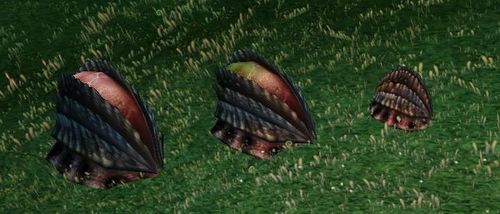From EncyclopAtys
m |
m |
||
| Line 43: | Line 43: | ||
Each tiny hermaphroditic animal grows, with a spongy foot bound to the ground, a very hard shell of the same type as those of the shellfish of the [[Lakes]], with the same protective function. The central part is soft and slimy and serves as mouth, stomach and reproductive organ. As individuals grow, they merge to give the appearance of a single creature. | Each tiny hermaphroditic animal grows, with a spongy foot bound to the ground, a very hard shell of the same type as those of the shellfish of the [[Lakes]], with the same protective function. The central part is soft and slimy and serves as mouth, stomach and reproductive organ. As individuals grow, they merge to give the appearance of a single creature. | ||
| − | The development of the magnifying lenses by the [[Trykers]] allowed its observation. It filters out small organisms (animal and vegetable) that flutter around at the whim of the hot and humid winds of the Prime Roots. | + | The development of the magnifying lenses by the [[Trykers]] allowed its observation. It filters out small organisms (animal and vegetable) that flutter around at the whim of the hot and humid winds of the Prime Roots. At maturity, tiny fragments detach themselves from the soft part and rise in the air to colonize another area. |
| − | + | Like many endemic organisms in the Prime Roots it is bioluminescent. | |
| − | + | It is virtually impossible to open a shut cokamool and homins know that you should not risk your fingers under penalty of mutilation. | |
[[File:Cokamool.jpg|500px|thumb|left|Cokamools at various stages of development]] | [[File:Cokamool.jpg|500px|thumb|left|Cokamools at various stages of development]] | ||
{{Clear}} | {{Clear}} | ||
Revision as of 19:17, 2 August 2019
| Taxonomic Amber | |
| Cokamool | |
|---|---|

| |
| Kingdom | {{{king}}} |
| Category | {{{species}}} |
| Main Ecosystem(s) | Prime Roots |
| Counterattack type | n.a. |
Actually, the cokamool (also know as cocoa is not a plant but a community of animals.
Each tiny hermaphroditic animal grows, with a spongy foot bound to the ground, a very hard shell of the same type as those of the shellfish of the Lakes, with the same protective function. The central part is soft and slimy and serves as mouth, stomach and reproductive organ. As individuals grow, they merge to give the appearance of a single creature.
The development of the magnifying lenses by the Trykers allowed its observation. It filters out small organisms (animal and vegetable) that flutter around at the whim of the hot and humid winds of the Prime Roots. At maturity, tiny fragments detach themselves from the soft part and rise in the air to colonize another area.
Like many endemic organisms in the Prime Roots it is bioluminescent.
It is virtually impossible to open a shut cokamool and homins know that you should not risk your fingers under penalty of mutilation.
| |
| |




